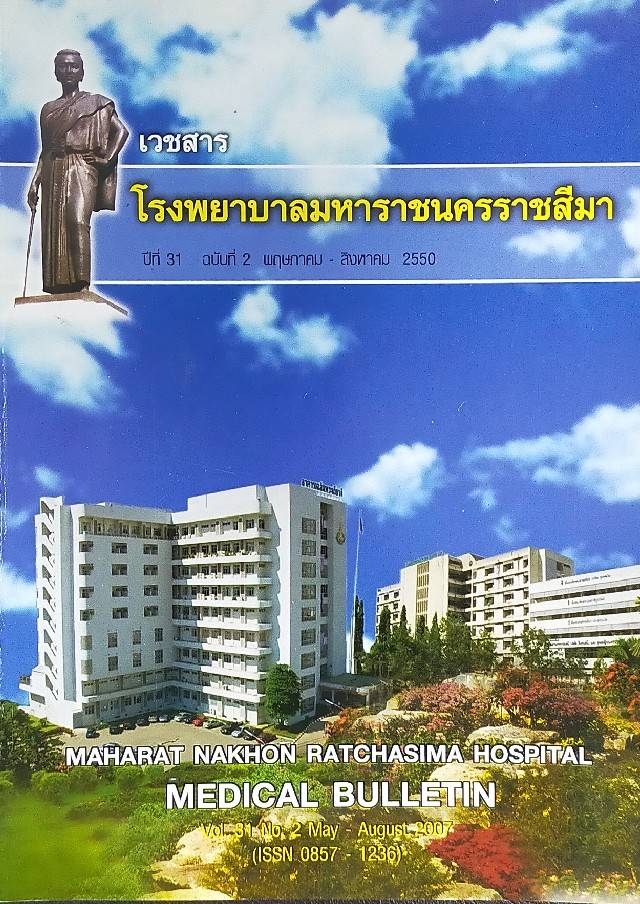Liver Tumors in Maharat Nakhon Ratchasima Hospital
Main Article Content
Abstract
Background: Liver tumors are common in clinical practice and it is important to differentiate cancer from benign tumors. Various supporting data can help accurate diagnosis possible. Objective: To analyze symptoms, signs, basic patient characteristics, laboratory tests and x-ray findings of liver tumor patients in Maharat Nakhon Ratchasima Hospital. Materials and Methods: Retrospective study was performed from medical records of liver tumor patients in Maharat Nakhon Ratchasima Hospital who were admitted from August 1, 2003 to July 31, 2004. Data were collected and analyzed. Results: 294 liver tumor patients in Maharat Nakhon Ratchasima Hospital were diagnosed. Average age was 59.1 ±13.8 year with age range 20-89 years. They were 219 males (74.5%) and 272 were cancer patients (92.5%) that consisted of hepatoma, cholangiocarcinoma and metastatic liver tumor 43.9%, 42.2% and 6.5% respectively, 22 were benign liver tumor patients (7.5%) that the most common was hepatic hemangioma. When we compared the patient characteristics between the cancer group and the benign one. We found that the former had more male ratio, more non Amphur Muang district of Nakhon Ratchasima province, more alcohol drinking history, short beginning period of disease and larger liver tumor size. For symptoms and signs, the former had more icterus, more loss of body weight, bigger hepatomegaly, and more severe anemia. For laboratory tests, the former had less hemoglobin, less albumin, more platelet, more SGOT, more total bilirubin, and more alkaline phosphates levels. Conclusion: 294 Liver tumor patients were found in Maharat Nakhon Ratchasima Hospital during August 1, 2003 to July 31, 2004 with were more commonly found in predicted liver cancers were male sex, big liver tumor size, and icterus, loss of body weight, hepatomegaly, anemia, high SGOT, high total bilirubin and high alkaline phosphatase.
Article Details

This work is licensed under a Creative Commons Attribution-NonCommercial-NoDerivatives 4.0 International License.
References
Talwalkar JA, Gores GJ. Diagnosis and Staging of Hepatocellular Carcinoma Gastroenterology 2004; 127: S126-S132.
Sherman M. Hepatocellular carcinoma.Epidemiology, risk factors, and screening. Semin Liver Dis 2005; 25 : 143-54.
Fattovich G, Stroffolini T, Zagni I, Donato F. Hepatocellular carcinoma in cirthosis: incidence and risk factors. Gastroenterology. 2004 Nov; 127(5 Suppl 1): S35-50. Review
Hoofnagle JH. Hepatocellular carcinoma: summary and recommendations. Gastroenterology 2004; 127(5 Suppl 1): S319-23. Review.
Befeler AS, Di Bisceglic AM. Hepatocellular carcinoma: diagnosis and treatment. Gastroenterology 2002; 122(6): 1609-19. Review
de Groen PC, Gores GJ, LaRusso NF, Gunderson LL, Nagorney, DM. Biliary Tract Cancers. N Engl Med 1999; 341: 1368-78.
Bloom CM, Langer B, Wilson SR. Role of US in the detection, characterization, and staging of cholagiocar~cinoma. Radiographics 1999; 19: 1199-218.
Regev A. Benign solid tumors. In: Schiff ER, Sorrell MF, Maddrey WC, editors. Schiff's Diseases of The Liver. 9th ed. Philadelphia: Lippincott Williams & Wilkins; 2003. p.1201-29.
สมชาย เหลืองจารุ. Hepatic Carvemous Hemangioma with Kasabach-Merritt Syndrome: รายงานผู้ป่วย 1 ราย และทบทวนวารสาร. เวชสารโรงพยาบาลมหาราชนครราชสีมา2545; 26: 145-50.


